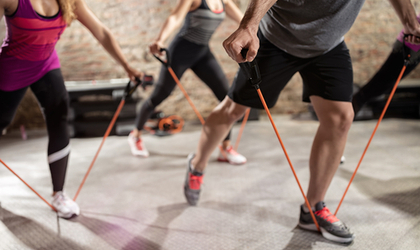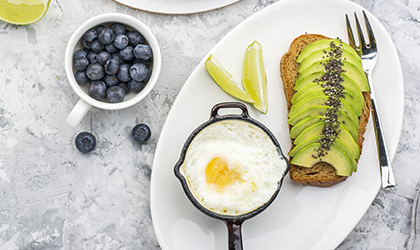
Exercise is important for good health. But we tend to limit ourselves to one or two types of activity, when really, the key to a healthy, happy body is through a combination of key types of exercise. In this guide, we’ll break down a number of exercise types to consider introducing into your routine, as well as giving tips and tricks on the best activities and nutrition to accompany them.
HIIT (high-intensity interval training)
Want to get lean, get conditioned, and get toned? We can’t promise HIIT is easy, but it will certainly deliver on these results if done properly. Forget those 90-minute gym sessions; all you need is 30 minutes of interval training to feel the burn, build agility and increase overall fitness.
What is HIIT?
HIIT denotes any workout that alternates between intense bursts of activity and fixed periods of less intense activity or even complete rest. A good starter activity is running as fast as you can for 1 minute and then walking for 2 minutes. Exhausting? You bet. But it works.
Benefits of HIIT exercise
Sure, it’s tough, but there’s a reason for all the HIIT hype. It’s a super-efficient workout; all you need is 15 minutes, 3 times per week, to reap the rewards. It will help you lose weight – not muscle, and thanks to pushing into the anaerobic zone (that delightful place where you’re breathing extremely hard and aren’t able to say full sentences), HIIT helps build a healthier heart, too. As a general rule of thumb, doing a HIIT workout 2-3 times a week will show great results while still allowing yourself to recover.
Nourish with nutrition It’s vital to refuel the right way after your HIIT workout. This will prevent your energy levels from crashing and promote lean muscle synthesis. Ideally, your post-HIIT meal should be high in protein, with good amounts of healthy carbs and fats in there too. A delicious option is overnight oats – simply combine oats with yoghurt or milk, mashed banana and chia seeds.
Strength Training and Muscle-Building Exercises
To build muscle and strength, you need to eat right, train hard and get rest. It’s the trinity of bulking up. Yes, it takes time – not to mention determination and a bucket load of sweat – but with the correct application, you’ll see the results you want.
Pump iron
Lifting heavy weights damages your muscle fibres, which stimulates muscle growth in response. Plan to lift heavier and heavier weights gradually, so you develop more muscle to carry the load. The easiest way to build muscle is by exercising the biggest muscle groups: back, legs and chest. Squats, pull-ups, bench presses, triceps dips and deadlifts will work them most efficiently.
Exercises to build strength
The deadlift, squat, shoulder press, and bench press are the top strength-building exercises. Try sticking to three or four lifts per workout. While you should alternate different rep ranges in your workouts, 5-8 reps for 2-6 sets seem to offer the best combination for strength gains and muscle size.
Full-motion – Aim for the largest range of motion you can achieve in each exercise. This way, your muscles will do more work per rep.
Nutrition basics
To gain mass and muscle, you need fuel – and lots of it. Now isn’t the time to skimp on calories. On the contrary, you actually need a caloric surplus (i.e. enough calories to maintain your current weight, plus powering all your extra training and subsequent muscle growth). To work out your required calorie intake, follow these equations:
Men: multiply your weight in pounds by 18 if you’re least active, 20 if you’re moderately active (e.g. 50 minutes of jogging per day), or 22 if you’re very active (e.g. 2 hours of jogging per day).
Women: multiply your weight in pounds by 16 if you’re least active, 17 if you’re moderately active or 18 if you’re very active.
However, this doesn't mean you can eat anything you want within this calorie intake and still see results. Increasing muscle mass calls for a diet of protein, healthy fats, and carbs. Your muscles need protein for repair, maintenance and growth. Load up on lean meats, dairy, vegetables and pulses. Plant-based protein sources, like nuts and seeds, grains and vegetables, are also good options, however, they need to be combined with the correct amino acids to become ‘complete’. Finally, you’ll need low GI carbs (brown pasta, rice and sweet potato) to provide your body with sustained energy and prevent sudden spikes in your blood sugar.
Equal parts rest and reps
Importantly, remember that you don’t gain muscle in the gym. Working out merely does the damage your body needs to respond to. Hence, proper rest is instrumental in building muscle, but also for avoiding the occurrence of a sports injury. Train one day, and rest the next to see maximum results from the hard work you’re putting in.1
Flexibility Training
Think touching your toes is an unrealistic goal you’ll never see to fruition? Think again. A well-rounded exercise programme coupled with the correct nutrition, hydration and healthy lifestyle choices can have a significant impact on your flexibility.
Exercises for flexibility
Yoga, Pilates and Tai Chi are some of the best physical activities to improve flexibility and core muscles. Gone are the days of static stretching (i.e. holding a muscle in a stretched position for roughly 30 seconds) before exercise. Instead, focus on doing a sequence of dynamic stretches like side lunges, jumping jacks, squats and push-ups. Perform three sets of each movement for 20-30 reps to warm-up your entire body. Oh, and don’t think you’re getting out of a cool-down either. Now you can throw some traditional static stretches into the mix. These poses will help to lengthen tense muscles and relax stiff joints.
Foods for flexibility
Diet is equally important when it comes to flexibility. Thanks to their high water content, eating a wide range of fresh fruits and dark green leafy veggies can increase flexibility by nourishing and lubricating the muscles. Filling up on healthy fats – oily fish (2-3 portions of salmon, anchovies and mackerel every week), avocados, nuts and seeds – is another delicious option. Their rich omega 3 content may support elasticity and joint mobility. We should also mention ginger and turmeric – while turmeric is thought to support joint mobility, ginger promotes healthy muscle and joint mobility function, so add them liberally to food!
Relax and unwind
Have you ever felt stressed to the point your neck seizes up? Yep, rising stress levels can have a pretty unpleasant effect on the body, causing huge knots to form. The solution? Take time to relax. Meditate. Learn the art of doing nothing. Get a massage – these can help break up knots in tissues that restrict movement.
So whether you fancy improving your flexibility, or wish to sweat hard with some HIIT, there is an exercise style to suit everyone. Remember though, practising a range of exercises is the key to a truly healthy lifestyle. For even more articles featuring health advice just like this, feel free to visit Health Library on our Pharmacy site or why not have a look further around our active lifestyle section on Our Blog.
References:
-
WARNING: a muscle-building routine takes its toll on your body. Make sure you’re in good nick before you start, and always get any aches and pain checked out by a medical professional.
You Might Also Like

Keri
Keri Filtness has worked in the Nutrition Industry for 19 years. She is regularly called upon for her professional comments on health and nutrition related news. Her opinions have been featured by BBC3, Prima, Vitality, The Mirror, Woman’s Own and Cycling Weekly, amongst others. She has also worked one to one with journalists, analysing their diets and health concerns and recommending changes and additions, where appropriate.
View More


